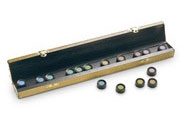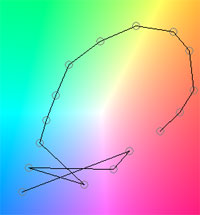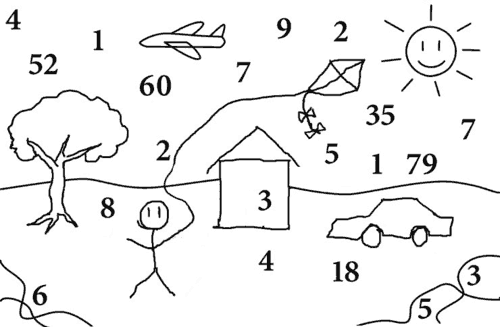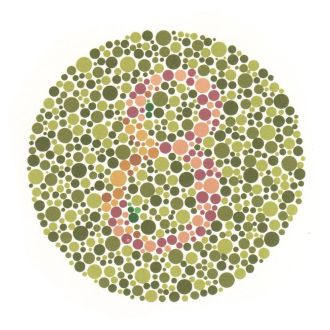By using a color arrangement test you can find out not only if you are colorblind at all but also the type and severity of your color vision deficiency. A color arrangement test consists of a given number of colored chips. These small discs are shuffled and then have to be arranged by the person under observation according to their similarities, starting from a fixed reference color.
While people not affected by any color vision deficiency will arrange it from blue through green, yellow, orange and red according to the hue circle, persons who suffer from some kind of color blindness have severe problems arranging the chips in the right order. They will have some crossovers in the hue circle, whereas the direction of the crossover indicates the type of color blindness.
There are three different well known color arrangement test:
- Farnsworth-Munsell 100-Hue Test, consisting of 85 colored chips which have to be arranged in the correct order. This test is very time consuming and reveals the type of color blindness but can not distinguish between dichromacy and anomalous trichromacy.
- Farnsworth Dichotomous Test (D-15), which is built out of 15 distinct color chips. The Farnsworth Dichotomous Test is useful for detecting dichromacys, in particular, tritan defects. A disadvantage is, that minor color vision defects can not be detected.
- Lanthony’s Desaturated 15-Hue Test has also 15 chips but in contrary to the Farnsworth Dichotomous Test the colors are less saturated. This makes the Lanthony Desaturated Test much more difficult and you therefore can detect more subtle color vision deficiencies.

Dean Farnsworth was a Commander stationed at the Naval Laboratory and developed the Farnsworth-Munsell 100-Hue Test and the Farnsworth Dichotomous Test (D-15) for the Navy. He developed the tests with the support of others between 1943 and 1947. They were used starting in 1955 for specific job placements.
You can find an online version of this test available here at Colblindor at Color Arrangement Test. All you have to do is to arrange the 15 color discs by similarity, starting with the reference disc. If finished the results are shown in two different representations:
- A graphical representation whereas each color chip is shown as a dot in the CIE-color diagram. The dots are connected with lines according to the order of your arrangement. Protan, deutan and tritan axis can be highlighted inside the diagram for an easy verification of the type of your color blindness.
- Scores according to Vingrys and King-Smith which are determined from the angles between the connecting lines, producing a color difference vector. The scores consist of three important values:
Angle, indicating the type of color deficiency,Confusion-Index, measuring the severity,Scatter-Index, assessing the degree of scatter.
After taking the test you can match your scores to the according values in a table, where all the different types of color blindness are listed. Through this matching and the comparison with the axis in the graphical representation you can verify your type and severity of color blindness.

On the left hand side you can see my test results as a graphical representation. I mainly mixed up hues from the beginning and the end of the color circle. As the test can primarily detect dichromacy I conclude, that I am not dichromatic but do have a very strong anomalous trichromacy. Looking at the axes of the connections they are a bit messy but are coming closest to the protanopia axis.
Try it out yourself. Maybe you even would like to compare your result not only to mine but also with some results from other tests for color blindness. You can find more articles about tests in the Tests Category.
Check the online version of the D-15 Color Arrangement Test here at Colblindor.


